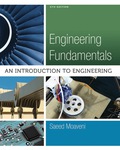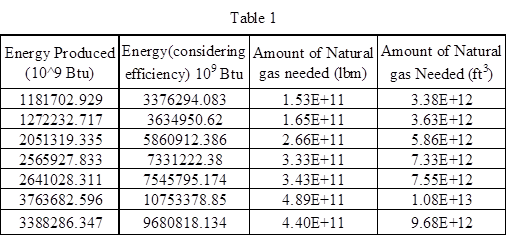
Concept explainers
Find the amount of natural gas required in
Answer to Problem 19P
The amount of natural gas required in
Explanation of Solution
Given data:
Refer to problem 13-19 accompanying table in the textbook.
The average efficiency of the power plant is 35%.
The heating value of the natural gas is
Formula used:
Formula to calculate the power plant efficiency is,
Rearrange the equation,
Convert Btu to
Convert
The value of the
Convert 1 hr into seconds,
Rearrange the equation,
Substitute equation (5) in equation (4),
Rearrange the equation,
Calculation:
Converting the given data from kWh to Btu:
Substitute
Substitute
Substitute
Substitute
Substitute
Substitute
Substitute
Now find the energy input fuel for each year in Btu for natural gas:
Substitute
Substitute
Substitute
Substitute
Substitute
Substitute
Substitute
Now convert Btu to lbm as follows by using the relation
Substitute
Substitute
Substitute
Substitute
Substitute
Substitute
Substitute
Now convert Form lbm to
Substitute
Substitute
Substitute
Substitute
Substitute
Substitute
Substitute
Therefore, the amount of natural gas in

Conclusion:
Hence, the amount of natural gas in
Want to see more full solutions like this?
Chapter 13 Solutions
EBK ENGINEERING FUNDAMENTALS: AN INTROD
- Please solve the question by hand with a detailed explanation of the steps.arrow_forwardAn average operating data for conventional activated sludge treatment plant is as follows: (1) Wastewater flow, Q = 50000m³/darrow_forwardA- Design grit removal chamber for a W.W.P with hourly flow equal 5000 m'h B-Answer five of the following: 1-....... is the storm runoff that occurs from rainfall? (15 mark) (10 mark) 2- A protective device used to remove large and coarse materials from the wastewater 3-....... utilize a relative porous bacteria growth medium such as rock or formed plastic shapes 4- There are two basic methods of introducing air into the aeration tanks are....... And ......... 5-..... to water bodies such as rivers will be described by Streeter- Phelp's equation 6- .... is the liquid conveyed by a sewer, it may consist of any one or a mixture of liquid wastes.arrow_forward
- (2) Volume of aeration tank, V-12000m (3) Influent BOD, Y.- 300 mg/1 (4) Effluent BOD, Y, 25 mg/1 (5) Mixed liquor suspended solids (MLSS), X,-2500mg/1 (6) Effluent suspended solids, X-30mg/1 (7) Waste sludge suspended solids, XR-9700mg/1 (8) Quantity of waste sludge, Q., 220m³/d 100 Based on the information above data, determine: (a) Aeration period (hrs.) (b) Food to microorganism ratio (F/M) (kg BOD per day/kg MLSS) (c) Percentage efficiency of BOD removal (d) Sludge age (days)arrow_forwardWrite handwritten solution, answer a,b and c Refer to the soil profile shown in the Figure a. Calculate the variation of o, u, and o' with depth. b. If the water table rises to the top of the ground surface, what is the change in the effective stress at the bottom of the clay layer? c. How many meters must the groundwater table rise to decrease the effective stress by 15 kN/m? at the bottom of the clay layer?arrow_forwardWater is discharged into the atmosphere through a bent nozzle of an angle (a) as shown in the figure. The cross-sectional area at the nozzle inlet and outlet are (Ain) and (Aout), respectively. The discharge through the nozzle is (Q). The gauge pressure at the nozzle inlet is (Pin). The bend lies in a horizontal plane. Vin Ain Aout Atmosphere Vout Problem (9): Given the values of Ain [m²], Aout [m²], Pin [atm], Q [m³/s], and a [degrees], calculate the magnitude of the reaction force component in x-direction (Rx) in [N]. Givens: A in = 0.301 m^2 Aout Pin = 0.177 m^2 1.338 atm Q α = 0.669 m^3/s 37.183 degrees Answers: ( 1 ) 23028.076 N ( 2 ) 29697.962 N ( 3 ) 18633.611 N ( 4 ) 14114.988 Narrow_forward
- Please answer the following question in the picture and show all of your work please.arrow_forwardPlease answer the following questions and make sure you answer each question please.arrow_forwardWater is discharged into the atmosphere through a bent nozzle of an angle (a) as shown in the figure. The cross-sectional area at the nozzle inlet and outlet are (Ain) and (Aout), respectively. The discharge through the nozzle is (Q). The gauge pressure at the nozzle inlet is (Pin). The bend lies in a horizontal plane. Ain Vin Aout X Atmosphere Vout Problem (10): Given the values of Ain [m2], Aout [m²], Pin [atm], Q [m³/s], and a [degrees], calculate the magnitude of the reaction force component in y-direction (Ry) in [N]. Givens: A in 0.169 m^2 A out Pin 0.143 m^2 0.552 atm = Q α 0.367 m^3/s = 31.72 degrees Answers: ( 1 ) 6264.193 N (2) 12041.886 N ( 3 ) 8715.747 N ( 4 ) 7139.937 Narrow_forward
- Problem (12): A pump is being used to lift water from the bottom tank to the top tank in a pipe of diameter (d) at a discharge (Q). The pipe system comprises four Long radius 90° threaded elbows. The pipe entrance is sharp-edged, and the pipe exit is sudden. A Ball valve (1/3 closed) is used to control the discharge in the pipeline. Given the values of Q [Lit/s], and d [cm], calculate the power loss due to components (i.e., minor losses) in the pipe (Wminor-loss) in [W]. Givens: Q = 12.275 lit/s d = 6.266 cm Answers: ( 1 ) 1142.006 W (2) 952.086 W ( 3 ) 1225.555 W ( 4 ) 1331.216 W Loss Coefficients for Pipe Components (h,= K,Y) Component a. Elbows KL elbow Regular 90°, flanged 0.3 Regular 90°, threaded 1.5 Long radius 90°, flanged 0.2 V 90° elbow Long radius 90°, threaded 0.7 Long radius 45°, flanged 0.2 0.4 Regular 45°, threaded . 180° return bends 180° return bend, flanged 0.2 V 45° elbow 180° return bend, threaded 1.5 c. Tees Line flow, flanged 0.2 Line flow, threaded 0.9 180°…arrow_forwardCompute for the stresses (initial, const and final stage) and check for compliance in NSCP provisions. Also compute the following: 1. Compute and check if the section is Uncracked, Transition or Cracked as per NSCP. 2. Compute for its flexural capacity and check if it could carry the given load. BEAM SECTION NOT TO SCALE 1400mm 300 $1098 400 */ 400*300* 300 200 300 100 ORIGINAL SECTION/PRECA CAST-IN-PLACE (CIP) PART PRECAST LOADING AT SERVICE M • 21 KN (DEAD LOAD ONLY) 21KN 4.75m 9.25m CIVEN DATA STRANDS: 12-02 AT 120KN/STRAND (GOMM FROM BOTTOM) 8-2 AT 120HN/STRAND (120mm FROM BOTTOM) fc 42.5 MPa (BEAM) fc 38 MPa (CIP) f'a = 80% or fa fp-1860 MPa ESTRANDS 1976Pa OONG 23.6/m³ LOES 1-8% Loss 18% APPLY 3M LIVE LOAD AT CONST. PHASEarrow_forward4. Determine the stability of the cantilever shown in the figure below (use Coulomb earth theory for the lateral stress due to the backfill material). 1 m 0.5 m Backfill 7 = 18.5 kN/m³ • = 30° 20 6 = 20° 6 m Y₁ = 24 kN/m³ 1.2 m 1 m 4.5 m Base soil Clay: 7 = 19 kN/m³,0 = 30%, 0,, = 20°, s,, = 94 kPa a. With s₁ = c = 94 kPa (disregard values), determine allowable soil bearing capacity of the base soil if the factor of safety is equal to 3. b. Determine the FS against overturning. C. Determine the FS against sliding if the coefficient of friction between footing concrete base and soil is b. d. Determine the FS for bearing capacity.arrow_forward
 Engineering Fundamentals: An Introduction to Engi...Civil EngineeringISBN:9781305084766Author:Saeed MoaveniPublisher:Cengage Learning
Engineering Fundamentals: An Introduction to Engi...Civil EngineeringISBN:9781305084766Author:Saeed MoaveniPublisher:Cengage Learning
 Sustainable EnergyCivil EngineeringISBN:9781133108689Author:Richard A. DunlapPublisher:Cengage Learning
Sustainable EnergyCivil EngineeringISBN:9781133108689Author:Richard A. DunlapPublisher:Cengage Learning


